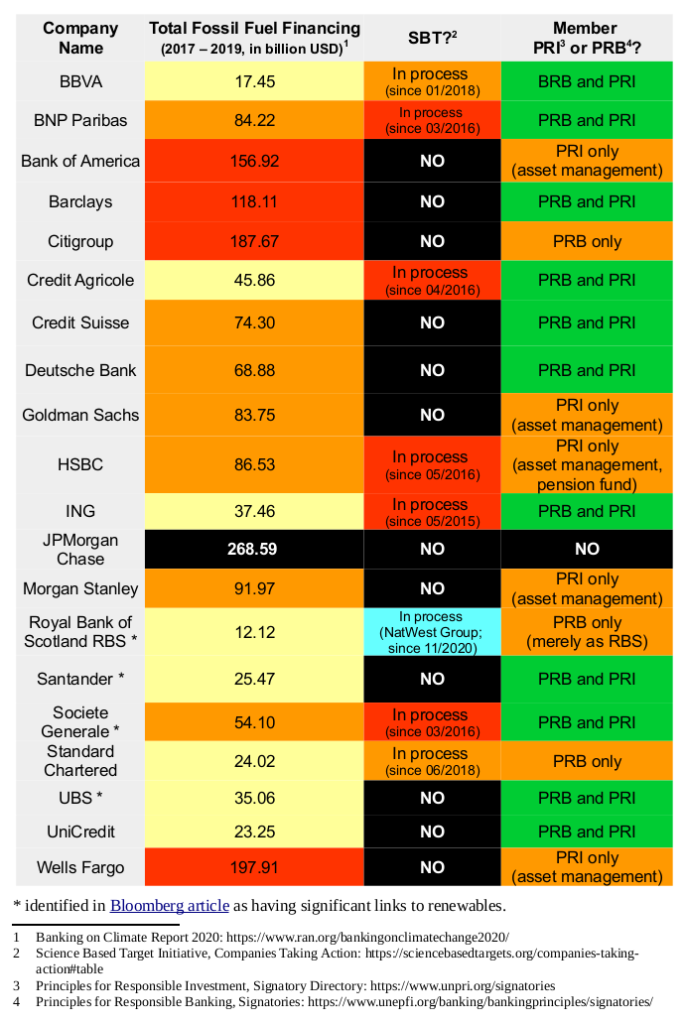
In last week’s post I’ve looked at the Blooomberg research that analysed the track record of Board of Directors (BoDs) of the world’s 20 largest banks, and how knowledge and skill around in the ESG (sustainability) area favourably correlated with the bank’s investments into renewables.
In this post I would like to look at the flip side of those BoDs by looking at the same 20 largest banks and how they engage/perform in three (3) dimensions:
- Fossil Fuel Financing (in total of USD investments made)
- Engagement with the Science Based Target Initiative, and
- Engagement with
either
the Principles for Responsible Investments (targetting asset managers) and/or
the Principles for Responsible Banking
(both of which are originally spin offs from the UN Finance Initiative).
The Why
Carbon – together with biodiversity – is one of THE most critical dimensions among the Planetary Boundaries. Because the already existing overshoot is putting our civilisation at risk. So far nothing new under the sun.
However, while biodiversity overshoot is not easy to measure, carbon is a different story entirely. It is so relatively easy to measure that doing so is even enshrined in reporting requirements for listed companies. Example of which are the TCFD (Taskforce for Climate-related Financial Disclosure) recommendations – by now often indeed turned into a requirement – to show investors scenarios with varying carbon/temperature trajectories and the risk for the company.
The big elephant in the room is of course:
- How do companies perform right now in terms of their carbon footprint? And:
- Do they have at the least commitments to work on a Paris Agreement trajectory?
Finance Industry, Banking, and the Paris Agreement
Most of readers will know the Science-based Targets initiative. A 5-step process for companies to commit, then set, and subsequently report against climate goals in alignment with the Paris Climate Agreement. Any company with aspirations to be public about their commitment can do so by signing up, and then moving through this quite rigorous process.
What is much tougher to know is the companies’ status quo , i.e. where they are right now on this journey. And how big the spread between status quo and publicly committed aspiration is. And hence also, how challenging their effort may proof to be in the years to come.
When I looked at fashion companies and their carbon trajectory, I was able to rely on data coming out of the finance industry (specifically: from GlobalanceWorld), intended to scrutinise investable assets.
Ironically, the same does not hold true this time: While all the major banks globally represent stocks that can be invested in, the data on their Warming Potential let me down. Not a single of the largest 20 banks had a ‘Warming Potential Value’ associated with them.
This said, what does exist is their track record in terms of Total Fossil Fuel Investments, at the very least for the last three years (2017 to 2019). This data speaks likely even louder than any investor assessment.
Hence, armed with the list of participants in the Science-Based Targets initiative, the 2020 ‘Banking on Climate’ report, as well as the signatory lists of both, the Principles for Responsible Investments and the Principles for Responsible Banking, the following table summarises the insights we can glean by comparing them side-by-side

Looking over the table, it is clear: the finance industry overall is far away from being ‘on track’. Or ‘on trajectory’.
In the case of these 20 banks, the lack of ESG expertise on the BoDs is ever so evident. Interestingly, just like in the Bloomberg research, those banks with ESG-experienced directors do have a much more ‘future ready’ profile, albeit they also have still work carved out for them.
It is also interesting to see of the 5 worst performers in terms of Fossil Fuel Investments 4 are headquartered in the US (and one in the UK). They are also consistent in that neither of them has any engagement with the SBTI.
What is further fascinating to observe, is that some reasonably well performing banks stay away from the SBTs but are involved in both the PRI and the PRB, both of which require stringent annual performance improvements across a broad set of of variables (in addition to carbon trajectory, this includes a variety of Planetary Boundaries and social parameters). This raises the question if indeed the SBTs are seen as suitable for what is considered a ‘lever’ industry.
That something is amiss between the finance industry and the SBTI is further apparent when looking at the engagement dates of those players that have links: with a single exception (RBS) the commitment dates back well over 2 years. And 2 years is normally the time frame allowed to go through the target definition, approval and publication process. The way it looks, the finance industry may indeed have overall dropped aspirations to engage seriously with the SBTs, and instead has chosen to walk a different path.
But why do even the best of all performers still have a good few billions invested into fossil fuel?
In my view there are a few reasons for that.
- Divestment from fossil fuels takes time. Albeit not so much the act of divestment itself, but rather the consultation process with those institutions and individuals that actually hold the investment in the form of stocks. These are not normally the banks themselves.
- In order to even consider a Just Transition – away from fossil fuel towards renewables under consideration of jobs and social factors – investment is also needed. And for the time being such investments do still go into the accounts of players classified as ‘fossil fuel’ companies.
- Fossil fuel investments, for a variety of reasons including the size of the physical assets involved in that industry, is expensive. And that can be seen in the above list. Even the best players own a couple of dozen of billions of USD worth of investments. This is a phenomenon that is not untypical for infrastructure investments – and at least for when concerns a transition process, that is what we are largely talking about.
There is no doubt, the Finance Industry is not doing well at all in terms of getting future fit and future ready. But there is a glimmer of hope. Looking at the large gap between the best and the worst players, there seem to be some enlightened banks around that take the issue seriously. Having suitably ESG-experienced directors on the board does indeed make a difference it seems. What we need to see now, is that the speed of change quickens.

